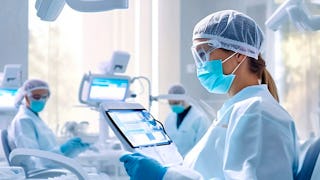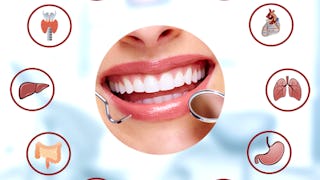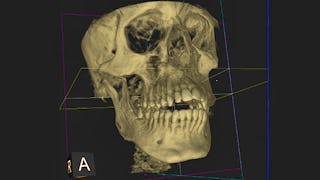In this course, Frontiers in Dentistry, you will be able to explore some of the latest advances in the field of dental medicine. The innovations in therapeutic techniques as well as our understanding of the biomedical sciences have been made possible by our research enterprise which integrates the latest emerging technology along with interdisciplinary collaborations.

Enjoy unlimited growth with a year of Coursera Plus for $199 (regularly $399). Save now.

Frontiers in Dentistry
This course is part of The Integration of Art and Science in Modern Dental Medicine Specialization

Instructor: Dr. Uri Hangorsky
4,557 already enrolled
Included with
(53 reviews)
Recommended experience
What you'll learn
You will learn about five evolving domains of dentistry and how it addresses the clinical needs of the population.
You will learn about the varying therapeutic and scientific innovations that have been incorporated into each practice and how they benefit patients.
You will learn about the various technology advancements that have enabled these dental domains to develop.
Skills you'll gain
Details to know

Add to your LinkedIn profile
5 assignments
See how employees at top companies are mastering in-demand skills

Build your subject-matter expertise
- Learn new concepts from industry experts
- Gain a foundational understanding of a subject or tool
- Develop job-relevant skills with hands-on projects
- Earn a shareable career certificate

There are 6 modules in this course
Throughout this course, you will be provided the opportunity to explore some of the latest, most fascinating advances in dental medicine. These innovations in therapeutic techniques as well as our understanding of the biomedical sciences have been made possible by our research enterprise which integrates the latest emerging technology along with interdisciplinary collaborations. We will begin the course with a warm welcome from Penn Dental Medicine's Morton Amsterdam Dean, Dr. Mark Wolff, and a brief introduction to the five domains that we will be discussing in this course. You will also get the opportunity to tell us more about yourself and your hopes for this learning experience. Let's get started!
What's included
1 video2 readings1 discussion prompt
The University of Pennsylvania provides a unique sense of collaboration that fosters cross-discipline partnerships. The Center for Innovation & Precision Dentistry (CiPD) is a vibrant community of experts in Penn Dental Medicine and Penn’s School of Engineering and Applied Sciences who leverage cutting-edge yet affordable approaches. The CiPD allows for accelerated discovery and translation of new therapies, diagnostics, and devices to address unmet needs in oral health. The CiPD also trains the next generation of leaders in dental, oral, and craniofacial research, and oral healthcare innovation. Several completed and in-progress projects will be highlighted in this week's module in an interview with Dr. Michel Koo, a Professor at the School of Dental Medicine and the co-Director of the Center for Innovation & Precision Dentistry (CiPD) at the University of Pennsylvania.
What's included
1 video2 readings1 assignment
For the 61 million Americans who have disabilities, going to the dentist can be a harrowing experience. There are many things to consider, including accessibility, finding care, and geographic proximity. Patients with hearing impediments, cognitive impairments, physical challenges, age, or disease-related difficulties need dentists, along with spaces designed for them and their caregivers. Mainstream healthcare providers are not often taught how to take different disabilities into consideration in their practices and treatment planning, which impacts millions of Americans’ access to healthcare every year. Minimally invasive care techniques that might not be typically considered in treatment planning are strong tools when treating patients whose disabilities might prevent them from receiving traditional treatment techniques. The Penn Dental Care Center for Persons with Disabilities is a unique opportunity for both patients and providers. It gives patients a tailored experience, taking into consideration a multitude of accessibility concerns. Students are given direct experience in treating patients with alternative needs as well as a good example of what accessibility looks like when considering their futures beyond Penn Dental Medicine. The ability of academic institutions to train the next generation of dentists who will be capable of treating patients with disabilities while also being cognizant of the various attitudinal, physical, and financial barriers is one of the formidable challenges facing the dental profession. To discuss these and other related issues we have invited one of the experts in this area, Dr. Miriam Robbins.
What's included
3 videos3 readings1 assignment
This module will discuss the up-to-date clinical and laboratory biomaterials research, focusing on esthetic dentistry, minimally invasive and adhesive dentistry, implant prosthodontics, novel materials, and modern CAD/CAM technologies. Which have improved our diagnostic capabilities and clinical outcomes. Combining advances in adhesive dental materials with advances in digital technologies, such as AI, provides a less invasive and more aesthetic outcome for the patient. These advances make calibration and communication between providers and specialties easier and more cost-effective. As the technology advances, dental professionals can provide more tailored and precise treatment to more patients at a lower cost and in fewer steps. We have invited an expert in this field, Dr. Markus Blatz, to provide more information about this domain.
What's included
1 video2 readings1 assignment
This module delves deeper into the advances of Computer-Aided Design and Computer-Aided Manufacturing (CAD/CAM) technologies and artificial intelligence. One of the most exciting frontiers and innovations in dentistry has been the recent incorporation of computer-controlled components in patients’ diagnostic and clinical procedures. This computer-controlled approach to dental therapeutics is widely known as digital dentistry and it has the potential to increase both the efficiency and effectiveness of clinical treatment resulting in better clinical outcomes. CAD/CAM technology has been around for several decades but has advanced significantly during that time with the addition of artificial intelligence. AI has enabled CAD/CAM technology to extend into the realm of diagnostics, and software is now able to identify potential risk factors in patients. In addition, intraoral scans provide a digital clone of the patient, allowing for better treatment planning and visual communication with the patient and in fewer appointments. These methods also reduce the number of materials required to treat the patient and are more precise than traditional fabrication methods. This technology has become less expensive over time, making this less invasive technology more accessible to a great number of patients. To explain this fascinating area in dentistry is Dr. Conejo who is the Clinical CAD/CAM Director at the Department of Preventive and Restorative Sciences
What's included
1 video3 readings1 assignment
Orthodontics is the dental specialty dealing with the correction of irregularities of the teeth, such as malocclusion, often by the use of braces. This treatment aims to ensure the proper form and function of the dentition. Like many other medical entities, orthodontic therapy has been undergoing significant changes influenced by the rapidly emerging technology, one of which is the exciting field of clear aligner therapy. In orthodontics, the computer-based three-dimensional image, which shows the current status of teeth and consequently enables a detailed and precise photorealistic 3D model, is indeed a basis for an innovative approach to treatment. This approach has the possibility of making orthodontic therapy available to millions of individuals who have otherwise been unable to afford orthodontic care. We have invited Dr. Sam Kadan to discuss this newly emerging area.
What's included
1 video2 readings1 assignment
Earn a career certificate
Add this credential to your LinkedIn profile, resume, or CV. Share it on social media and in your performance review.
Instructor

Offered by
Explore more from Patient Care
 Status: Preview
Status: PreviewThe University of Hong Kong
 Status: Free Trial
Status: Free TrialUniversity of Pennsylvania
 Status: Free Trial
Status: Free TrialUniversity of Pennsylvania
 Status: Free Trial
Status: Free TrialUniversity of Pennsylvania
Why people choose Coursera for their career




Learner reviews
53 reviews
- 5 stars
88.67%
- 4 stars
7.54%
- 3 stars
3.77%
- 2 stars
0%
- 1 star
0%
Showing 3 of 53
Reviewed on Apr 5, 2025
Exceptional course explaining all recent advancements in dentistry in detail.
Reviewed on Sep 13, 2025
I learned so much! The modules were easy to follow and the discussion in the videos were interesting enough for me to stay engaged the entire time.
Reviewed on Sep 8, 2023
A great horizon was opened to me in this course, appreciating Penn.
Frequently asked questions
To access the course materials, assignments and to earn a Certificate, you will need to purchase the Certificate experience when you enroll in a course. You can try a Free Trial instead, or apply for Financial Aid. The course may offer 'Full Course, No Certificate' instead. This option lets you see all course materials, submit required assessments, and get a final grade. This also means that you will not be able to purchase a Certificate experience.
When you enroll in the course, you get access to all of the courses in the Specialization, and you earn a certificate when you complete the work. Your electronic Certificate will be added to your Accomplishments page - from there, you can print your Certificate or add it to your LinkedIn profile.
Yes. In select learning programs, you can apply for financial aid or a scholarship if you can’t afford the enrollment fee. If fin aid or scholarship is available for your learning program selection, you’ll find a link to apply on the description page.
More questions
Financial aid available,





